When most people think of bats, the typical reaction includes a fearful cringe because of the creatures’ reputation to cause chaos in the night skies and go after anything they can suck blood from. When I think of bats, I marvel at how these sophisticated mammals use their intelligence and small size to their advantage to live an assortment of different lifestyles worldwide. Contrary to popular belief, bats do not have intentions to rustle up chaos, and less than one percent feed on blood.

The author, Keegan Eveland
Believe it or not, the things that bats do behind the scenes result in products present in our everyday lives. Thanks to bats that eat half their weight in bugs, you can enjoy chocolate. By acting as a natural pest control, insectivorous bats save the United States’ agricultural industry about $3.7 billion a year. Fruit bats around the world are important too, as they eat fruit and disperse the seeds to produce new fruit trees. Without these flying superheroes around, our world would see a substantial impact on how we access and manage food.
The versatility and diversity of bats are what initially sparked my interest in learning more about them. Navigating the world by sound alone is a complex task. While some bats have great vision, most species have very poor eyesight and rely on acoustic means to orient themselves. Because of this challenge, they have mastered the craft of utilizing sound to sense the environment around them. Most bats have a highly developed ability to emit high-frequency vocal noises as soundwaves reflect off objects and surfaces back to them. They can then use this information to craft an accurate mental picture of their surroundings, generally called echolocation (Simmons and Stein, 1980). I was fascinated by their unique ability to sense the world differently than most other mammals through echolocation, and wanted to dig deeper into how they used that sensory modality to their benefit.
My mentor for this study, Laura Kloepper, a visiting assistant professor in biological sciences at the University of New Hampshire, researches population acoustics of bats and their behavior and other vocal species. With Dr. Kloepper’s support, I performed research in her Ecological Acoustics and Behavior lab at UNH, investigating how bats utilize their best asset, echolocation, to their advantage when traveling in large numbers to avoid colliding with those nearby.
It is crucial that we learn everything we can about bats to prepare them for a better future, as anthropogenic developments continue to encroach on their natural environments. By understanding more about how bats interact and navigate the world, we can instill effective conservation tactics that set bats up for success and allow for their auditory necessities to be conserved.
What Are Bats?
Bats can be anywhere from the size of a penny to having a six-foot wingspan (U.S. Department of The Interior, 2022) and are the only mammals with the ability of true powered flight. No other mammal can actively propel themselves through the air by using their muscles and flapping their wings, however some mammals, like sugar gliders and flying squirrels, glide through the air using air currents and updrafts. Their size puts bats in an advantageous position to squeeze into small spaces high up in caves, called their roosts (Brighton, Zusi, et. al., 2021). Their roosts can contain up to millions of bats at a time which facilitates a highly social lifestyle (Dechmann, Kranstauber, et. al., 2010). Their social life contains behaviors such as social grooming, shared parental care, and cooperative hunting. All these observed behaviors suggest that bats have very close social ties within their groups, called colonies, and have evolved mechanisms to overcome the challenges within their environments.
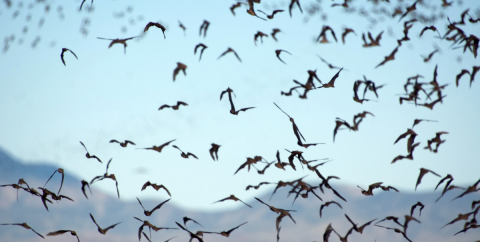
Emerging swarm of T. brasiliensis at the project's field site in New Mexico. Credit: Laura Kloepper.
This highly adaptable species has mastered the art of “seeing” without depending on their eyes. While it is relatively easy to navigate a wide-open area, it is much more difficult to navigate an area without bumping into thousands of your peers while moving in the same space. Bats have developed complex ways of avoiding each other while flying in a swarm of millions. My research investigated the auditory techniques that bats use to achieve this using primarily echolocation.
As echolocation is mainly a sensory modality, bats echolocate during flight to orient themselves in the space they are moving through (Boonman, Parsons, Jones, 2003). They can easily hear high frequency calls due to their innate ability to hear within the range of 9kHz–200kHz, whereas humans can only hear 20Hz–20kHz (Jones & Holderied, 2007), and therefore cannot hear most bats’ echolocation. The target species in this study, the Brazilian free-tailed bat (Tadarida brasiliensis), emits a common type of echolocation referred to as frequency-modulated (FM) echolocation. These echolocation calls are usually heard over varying frequencies, similar to birdsongs, and prepare bats excellently for hunting in wide-open spaces (Jones, 1999) in the southwestern United States.
After completing a research project on the spatial memory of fruit bats by working with collected sensory data from individual bats, I wanted to expand my scope to include a whole colony of bats. I had previously worked with Dr.Kloepper on analyzing giraffes’ acoustic data, and she suggested I use my acoustic skillset to conduct a study on when bats emerge from their caves. In the summer of my senior year, she became my mentor to conduct a complementary study on how echolocation calls change depending on one’s location within a swarm of bats.
Methodology
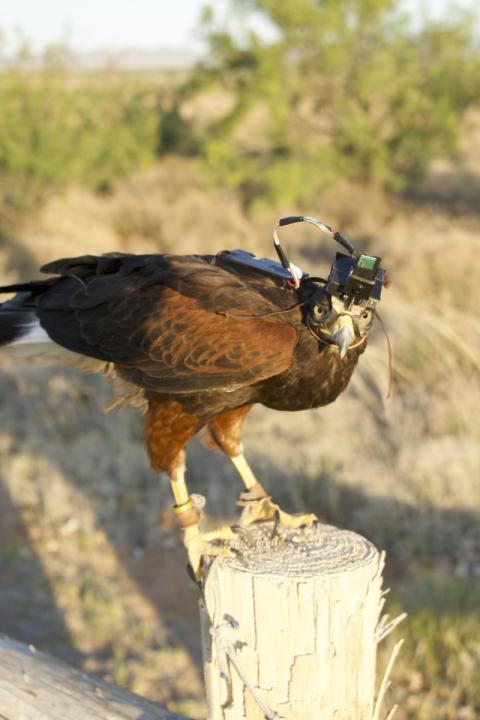
Figure 1: The microphone and camera unit that the hawk carried to collect data as she flew through the bat swarm. Click to enlarge.
For this project, I utilized a historic data set to investigate the difference of echolocation calls between bats in the middle and the edge of swarms. The data consisted of videos and audio files collected by Dr.Kloepper during previous field seasons in a cave system located in New Mexico. Dr. Kloepper and colleagues developed a new method of data collection where a trained Harris’s hawk flew through swarms of Brazilian free-tailed bats during peak emergence times, when bats were leaving their cave to go hunt. The hawk’s handler would stand at one side of the cave entrance, and Dr. Kloepper would stand on the other side while the hawk, wearing a backpack with a special microphone and camera unit, flew from one side to the other to collect data (Figure 1).
Once the data was organized, I synced the video and audio data and extracted singular passes to analyze them on an individual basis. Passes of the hawk through the swarm were determined by how close the hawk was to the outermost bat in the swarm. The beginning of a pass was determined to be when the hawk was within five bat body lengths (500 mm) of a bat, and the end of a pass used the same principle on the other side of the swarm (Figure 2). If the hawk did not fly in that proximity at all, then the pass was not included in the acoustic analysis. The end of a pass was determined by the same principle as the starting point after the hawk had flown through the center of the swarm.
Audacity is a classic open-source audio processing software that I used to assess the visual formations and various parameters of the acoustic data in spectrograms. Spectrograms, made in Audacity, are a visual representation of acoustic data and are widely used in acoustic studies. It is vital to see the visual components of what is occurring in the data to view the trends and structural shifts between echolocation pulses. I used Audacity to glean important acoustic information on parameters including call structure, range, and density. By looking at the visual structures of the echolocation calls, I was able to establish the typical range of frequencies that the bats were calling. In turn, I could apply that range when extracting quantitative data from the spectrograms to test for significance.
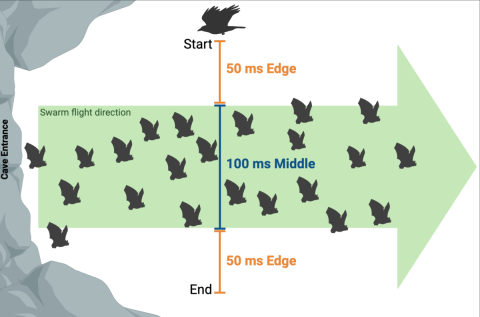
Figure 2: This diagram demonstrates how it was determined when the bats were in the middle or the edge of the swarm. When the hawk came within five bat body lengths (500 mm) the pass started. The pass ended when the hawk was within five bat body lengths of a bat on the other side of the swarm. Made with Biorender. Click to enlarge.
In many audio files there is a lot of background noise that interferes with data analysis such as wind, traffic, etc. To eliminate the unnecessary noise in my audio files, I applied a high-pass filter that muted noise below 10kHz. I then split the audio files into middle, left, and right in accordance with the orientation of the videos. From these three splits, I extracted a frequency spectrum from each orientation through a function in Audacity. A frequency spectrum is the distribution of amplitude values of a selection of audio and their corresponding frequencies. I exported those values into an Excel spreadsheet for each pass and standardized them to make sure the maximum of all values was the same.
In accordance with similar studies, the left and right sections were 50ms each (Schmidbauer & Denzinger, 2019). I statistically tested these sections to observe if there was a significant difference in their values. Because there was not, we combined them into 100ms sections labeled collectively as the edge. The middle was taken from the 100ms center section of the audio file when the bat was in the center of the swarm.
To perform statistics, I split the data for each condition (edge and middle) into eight different sections based on frequency. Each section represented a 10kHz segment from 20–100kHz. I calculated the average amplitude in these frequency sections for each condition (edge and middle). This allowed me to compare how the amplitudes changed over different frequencies. I performed a paired T-test for each segment to test whether there was a difference between the calls on the edge and middle of the swarm.
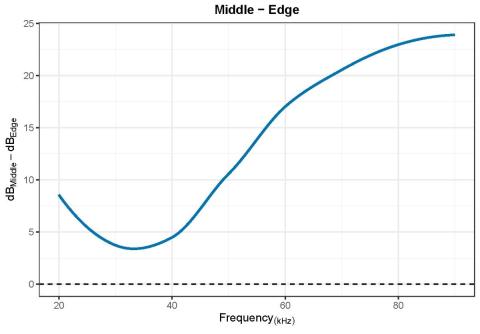
Figure 3: The above line graph shows the difference between the Middle and Edge (dB) conditions over a range of frequencies (kHz). If there is no difference, the line would approach zero dB as noted by the dotted line. Click to enlarge.
Results and Conclusions
After running paired t-tests, seven out of the eight frequency sections resulted in statistically significant differences between the edge and middle of the swarm. The frequency bin from 30-40kHz was the only section that was not significant, which aligns with the common frequency range in which bats echolocate (Tressler & Smotherman, 2009) (Figure 3). This relationship suggests that the soundscape, or acoustic environment of the bat swarms, shifts to produce more energy in higher frequencies in the middle when compared to the periphery of the swarm (Figure 4).
These results give insight into the bigger picture of how bats in swarms may avoid each other through echolocation. If the soundscape is shifting to have more energy in higher frequencies, that may mean that the bats are shifting their own call frequencies higher when in the middle of a swarm to distinguish their own calls from a bat next to them. This needs further study to confirm such a finding but sheds light on how bats differentiate their calls from the dense swarm surrounding them.
It is possible, however, that the results found in this study were influenced by other factors. It is known in acoustics that sound loses energy as it travels over prolonged distances (Bates, Simmons, Zorikov, 2011). This means that as soundwaves
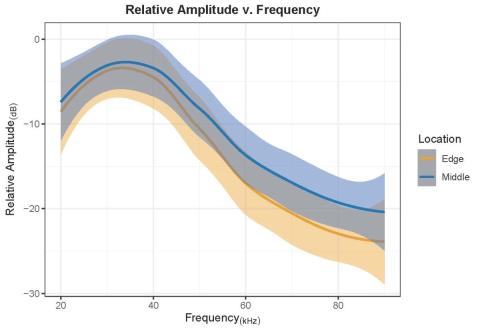
Figure 4: This graph shows the relative amplitude (dB) as a function of frequency (kHz) in terms of the two conditions (Middle and Edge). As frequency increases, the middle, blue, has more energy in relative amplitude than the edge, yellow. Click to enlarge.
leave the bat’s mouth and travel a prolonged distance to microphones picking up
the sound, the sound recorded is slightly different than when it was emitted. If the hawk that was flown through the colony was too far from the bats, then the distance would have altered the sound recorded by the attached microphone. There are also studies that show how the distance and size of the emitter can change the frequency perceived by the receiver due to the emitted sonar beam changing shape, becoming narrower at higher frequencies (Jakobson, Brinklov, Surlykke, 2013). (Figure 5.)
Another factor that could have influenced the study is the evolutionary relationship between the two species used in the study. Since the Harris’s hawk is one of the natural predators of the Brazilian free-tailed bat, it is likely that in typical conditions the bats would exhibit an antipredator response to the hawk. Responses out of instinctual fear would have a negative effect on this study which requires the traveling hawk to fly near the bats while collecting data. However, the hawk used in field data collection is a highly trained bird that does not prey on the bat swarm that it is flying through. Bats observed in the video data collected did not show any significant behavioral response that would prove to be problematic
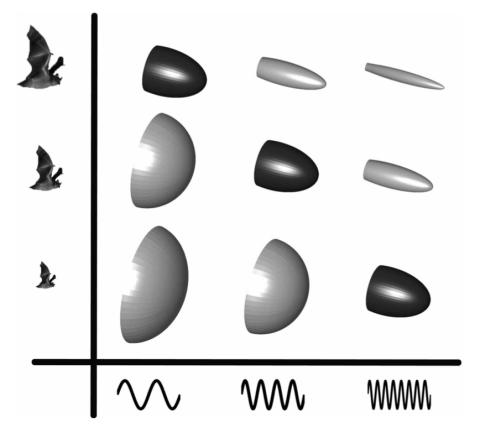
Figure 5: This figure illustrates how echolocation beam shape changes as emitter size and frequency are modified. As emitter size or frequency increases, the beam becomes increasingly narrow. Figure from Jakobson et al. (2013).
for the analysis.
While this study sheds light on how the swarms’ soundscapes are shifting and suggests that bats are changing their echolocation behavior to distinguish from their companions, there are still avenues that I anticipate future studies will explore. As mentioned prior, confirmation that the bats themselves are changing their emission frequency in the middle of a swarm is needed in future studies that tag individuals within a swarm. Exploring other parameters of their echolocation (intensity, duration, bandwidth, etc.) in swarms could also prove to be beneficial in revealing the mechanisms that they employ to avoid one another. Uncovering the means of how bats distinguish their calls with this new falconry method allows scientists to monitor the welfare of populations in a noninvasive way. Revealing the method in which they distinguish their calls in a dense soundscape sheds light on how anthropogenic noise can interfere with their natural mechanisms and allow conservationists to implement methods that respect their acoustic niche.
Personal Takeaways
While my results showed the relationship I was hoping for, this research opened my eyes to the other avenues that can be explored to strengthen my findings. Through this experiment, I learned how to use a bigger scope to investigate how bats interact to overcome the obstacles they face in their everyday lives as a colony. This project set me up for future success in my career by helping me grow as a student, scientist, and conservationist. I am now armed with a plethora of skills that will serve me in both my professional and personal future. It was so valuable to me to be able to run my own project for the first time and develop the time management skills to be both efficient and timely. During my time working on this project with Dr.Kloepper, I have been inspired to continue to do research on bats by pursuing another project with her in the spring of 2023. This project will investigate the role of echolocation and social calls of bats in an environment with multiple resident species. Through future and current research, unveiling the vocal differentiating mechanisms that bats use when flying in groups aids in the understanding of the anthropogenic effects from cities and construction zones near their natural habitat. Utilizing this new method of data collection via falconry is a groundbreaking noninvasive tool to monitor various populations and species.
I would like to thank Dr. Kloepper for playing an integral part in this project. Without her constant guidance and support, I wouldn’t have been able to gain such a deep understanding of this project and make it my own. I thank her for collecting the field data in collaboration with Paul Domski from the New Mexico Falconry Association and mentoring me through the length of this project. I thank Dr. Robert Stevenson from University of Notre Dame for the creation of the acoustic and video sensor the hawk carries. I also would like to thank Valerie Eddington who has been a great graduate student mentor who I was able to go to with any questions. It was crucial to have such supportive lab members and collaboration so that I could have confidence during the scientific process of this project.
References
Bates, M.E., Simmons, J.A., Zorikov, T.V. 2011. Bats Use Echo Harmonic Structure to Distinguish Their Targets from Background Clutter. Science. 333, 627-630.
Brighton, C.H., Zusi, L., et. al. 2021. Aerial attack strategies of hawks hunting bats, and the adaptive benefits of swarming. Behavioral Ecology. 32(3), 464-476.
Boonman A, Parsons S, Jones G. (2003). The influence of flight speed on the ranging performance of bats using frequency modulated echolocation pulses. The Journal of the Acoustical Society of America, 113, 617-628.
Dechmann DKN, Kranstauber B, Gibbs D, Wikelski M. 2010. Group Hunting—A Reason for Sociality in Molossid Bats?. PLOS ONE. 5(2).
Jakobsen, L., Brinkløv S., Surlykke, A. 2013. Intensity and directionality of bat echolocation signals. Frontiers in Psychology. 4(89).
Jones G, Holderied MW. 2007. Bat echolocation calls: Adaptation and convergent evolution. Proc. R. Soc. B, (274), 905–912.
Novick A. 1971. Echolocation in Bats: Some Aspects of Pulse Design. American Scientist, 59 (2), 198-209.
Schmidbauer, P., Denzinger, A. 2019. Social calls of Myotis nattereri during swarming: Call structure mirrors the different behavioral context. PLOS ONE. 14(9).
Simmons, J.A., Stein, R.A. 1980. Acoustic imaging in bat sonar: Echolocation signals and the evolution of echolocation. J. Comp. Physiol. 135, 61–84.
Tressler J, Smotherman MS. 2009. Context-dependent effects of noise on echolocation pulse characteristics in free-tailed bats. J Comp Physiol A Neuroethol Sens Neural Behav Physiol.195(10):923-34.
13 Awesome Facts About Bats. 2022. U.S. Department of The Interior. https://www.doi.gov/blog/13-facts-about-bats
Author and Mentor Bios
Keegan Eveland, from Clinton, Connecticut, will graduate in spring 2023 with a bachelor of science degree in zoology and a minor in animal behavior. Her research was done as an independent project for academic credit. Keegan had been interested in acoustics before starting this project, and she approached Dr.Kloepper with her idea after completing a research internship on bats using acoustic data. Keegan learned that bats are sophisticated problem solvers, especially in dense populations, and this drew her to do further research at a colony-wide scope of behavior rather than individual. Keegan successfully navigated the challenges of learning to code, managing her time, and working independently. Keegan decided to write for Inquiry to get the word out about how fascinating bats are, due to their ecological importance and little known impact on the health of our food system. Keegan aims to continue conducting behavioral acoustic research in bats long-term and she will be attending a graduate program in fall 2023 to continue this work. Her experience with this research confirmed her passion and fascination with bats and animal behavior.
Laura Kloepper is a visiting assistant professor in the Department of Biological Sciences at the University of New Hampshire. Dr. Kloepper specializes in acoustic ecology, and her research focuses on using acoustics to monitor dense aggregations of species and how animals in these dense groups adapt their acoustic behavior and movement. Keegan’s research is part of a larger project investigating echolocation adaptations of bats flying in dense swarms. Dr.Kloepper has been conducting this research for over ten years and has mentored over forty undergraduate students in independent research. The most satisfying part of this project for Dr. Kloepper was watching Keegan get as excited as she does about this kind of work. It was rewarding for Dr. Kloepper to assist Keegan in her research plans for graduate school and help her develop skills that she will continue to use and expand on. Dr. Kloepper believes that publishing undergraduate research builds effective communication, which is a critical skill for all scientists, and that it is important for scientists to learn how to explain their work to the general public.
Copyright 2023, Keegan Eveland
